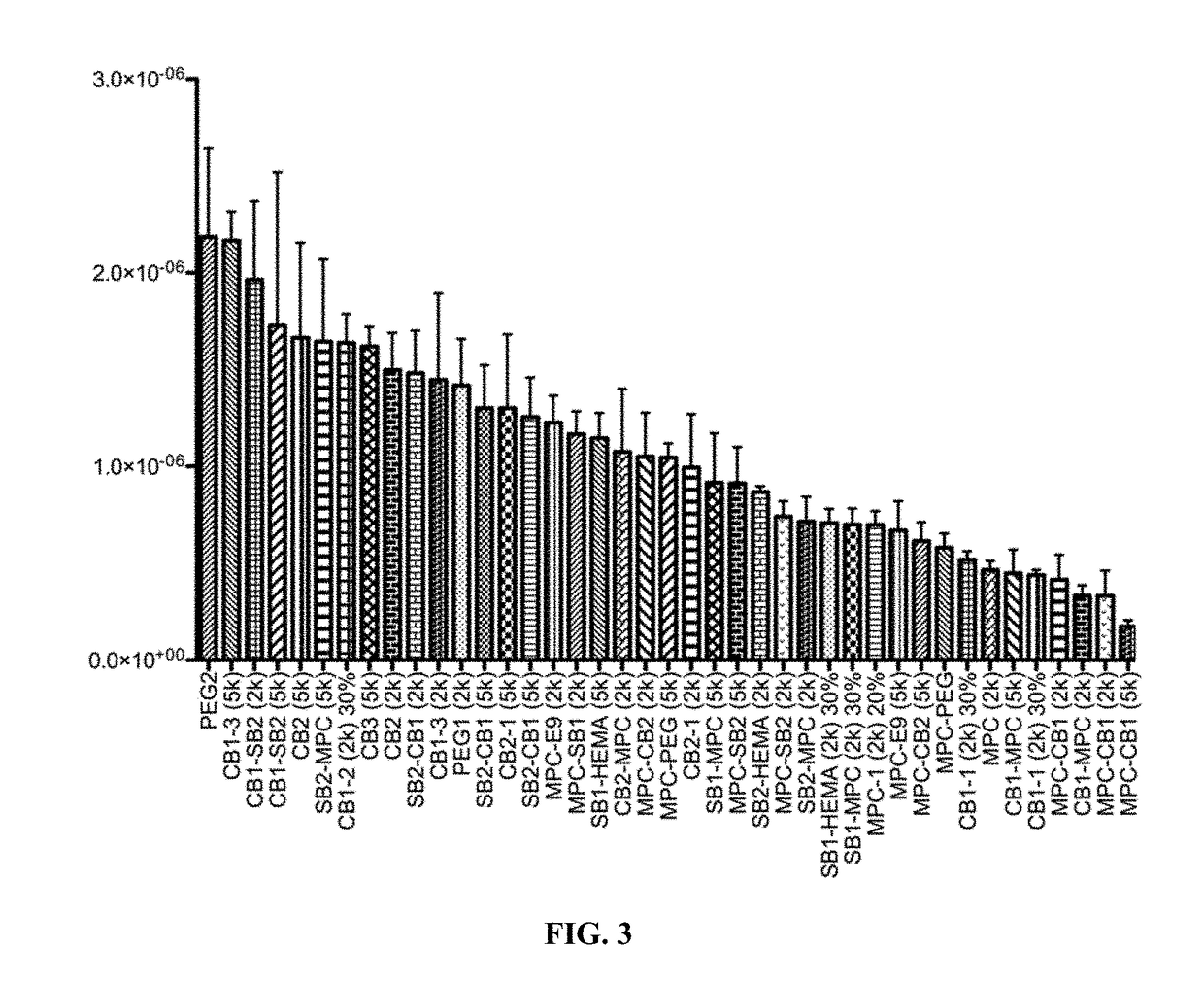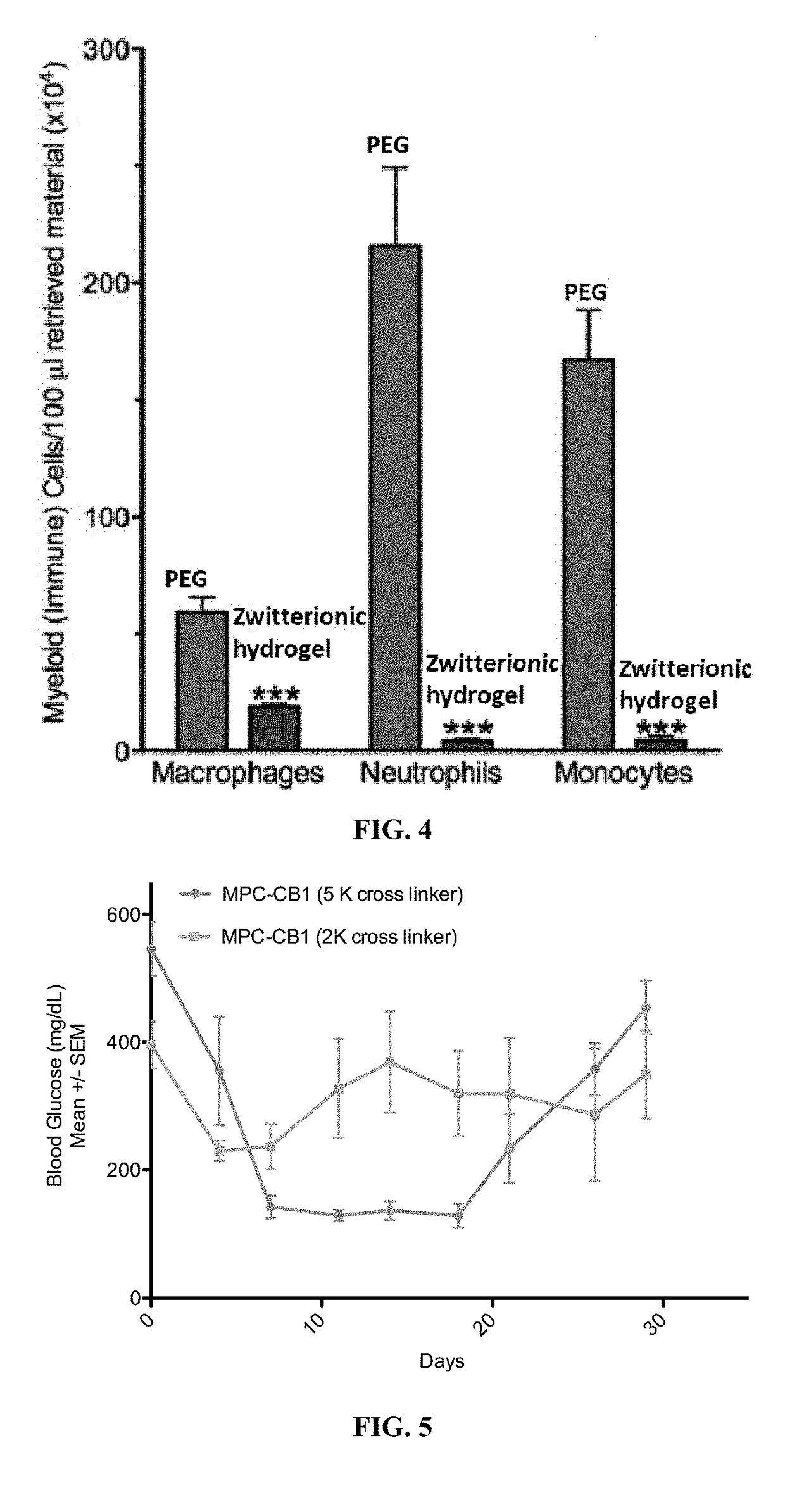Biocompatible coatings and hydrogels for reducing foreign body response and fibrosis
a technology of foreign body response and biocompatibility, applied in the field of biocompatibility-enhancing materials, can solve problems such as device failure and discomfort for recipients, and achieve the effect of reducing cell toxicity and improving biocompatibility
- Summary
- Abstract
- Description
- Claims
- Application Information
AI Technical Summary
Benefits of technology
Problems solved by technology
Method used
Image
Examples
example 1
rial Synthesis and Screening of Library of Zwitterionic Hydrogels
[0304]Using a combinatorial synthesis and screening strategy a broad library (more than 400 formulations) of zwitterionic acrylate hydrogels was generated, and the ability of each formulation to reduce foreign body response and fibrosis was tested.
Materials and Methods
[0305]Synthesis of Library of Zwitterionic Polymers
[0306]The zwitterionic monomers shown in FIGS. 1A-1G were synthesized in-house, and were used to generate a library of zwitterionic polymers using different combinations of these monomers, following the approach demonstrated in scheme 1 or scheme 2. Each zwitterionic polymer in the library was mixed with one or both of the cross-linkers shown in scheme 3 to cross-link the zwitterionic polymers to generate a library of zwitterionic hydrogels. See FIGS. 8A-8M. The cross-linking reaction was performed in saline solution.
[0307]In Vitro Screening Macrophage Adhesion Assay
[0308]Macrophage cells where seeded ont...
example 2
Zwitterionic Coatings to the Surfaces of Biomaterials
Materials
[0313]2-(Methacryloyloxy)ethyl 2-(trimethylammonio)ethylphosphate and (R)-α-lipoic acid were purchased from TCI Chemicals Inc. 2-aminoethyl methacrylate hydrochloride, 4-(dimethylamino)pyridine (DMAP), N-(3-dimethylaminopropyl)-N-ethylcarbodiimide hydrochloride (EDC.HCl), methanol, N,N-dimethylacetamide, dichloromethane (DCM), dimethylformamide (DMF), triethylamine (NEt3), sodium borohydride (NaBH4), 4-cyano-4-(phenylcarbonothioylthio)pentanoic acid, 4,4′-azobis(4-cyanovaleric acid), and dopamine hydrochloride salt were purchased from Sigma-Aldrich. Regenerated Cellulose Ester dialysis membrane tubing (2 kDa) was purchased from Spectrum Labs. Polystyrene microspheres (0.5 mm) was purchased from Phosphorex Inc. Cy3-conjugated anti-mouse alpha smooth muscle actin antibody was purchased from Sigma Aldrich. Filamentous actin (F-actin)-specific Alexa Fluor 488 conjugated Phallaoidin, and DAPI were purchased from Life Technolog...
PUM
| Property | Measurement | Unit |
|---|---|---|
| mean pore size | aaaaa | aaaaa |
| mean pore size | aaaaa | aaaaa |
| thickness | aaaaa | aaaaa |
Abstract
Description
Claims
Application Information
 Login to View More
Login to View More - R&D
- Intellectual Property
- Life Sciences
- Materials
- Tech Scout
- Unparalleled Data Quality
- Higher Quality Content
- 60% Fewer Hallucinations
Browse by: Latest US Patents, China's latest patents, Technical Efficacy Thesaurus, Application Domain, Technology Topic, Popular Technical Reports.
© 2025 PatSnap. All rights reserved.Legal|Privacy policy|Modern Slavery Act Transparency Statement|Sitemap|About US| Contact US: help@patsnap.com



